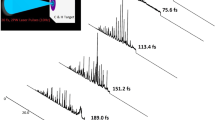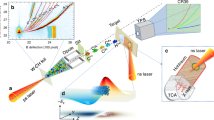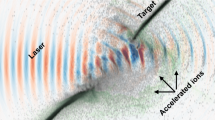Abstract
Acceleration of particles by intense laser–plasma interactions represents a rapidly evolving field of interest, as highlighted by the recent demonstration1,2,3,4 of laser-driven relativistic beams of monoenergetic electrons. Ultrahigh-intensity lasers can produce accelerating fields of 10 TV m-1 (1 TV = 1012 V), surpassing those in conventional accelerators by six orders of magnitude. Laser-driven ions with energies of several MeV per nucleon have also been produced5,6,7,8,9. Such ion beams exhibit unprecedented characteristics—short pulse lengths, high currents and low transverse emittance10—but their exponential energy spectra have almost 100% energy spread. This large energy spread, which is a consequence of the experimental conditions used to date, remains the biggest impediment to the wider use of this technology. Here we report the production of quasi-monoenergetic laser-driven C5+ ions with a vastly reduced energy spread of 17%. The ions have a mean energy of 3 MeV per nucleon (full-width at half-maximum ∼0.5 MeV per nucleon) and a longitudinal emittance of less than 2 × 10-6 eV s for pulse durations shorter than 1 ps. Such laser-driven, high-current, quasi-monoenergetic ion sources may enable significant advances in the development of compact MeV ion accelerators11, new diagnostics12,13, medical physics14, inertial confinement fusion and fast ignition15,16,17.
This is a preview of subscription content, access via your institution
Access options
Subscribe to this journal
Receive 51 print issues and online access
$199.00 per year
only $3.90 per issue
Buy this article
- Purchase on Springer Link
- Instant access to full article PDF
Prices may be subject to local taxes which are calculated during checkout



Similar content being viewed by others
References
Katsouleas, T. Accelerator physics: Electrons hang ten on laser wake. Nature 431, 515–516 (2004)
Faure, J. et al. A laser–plasma accelerator producing monoenergetic electron beams. Nature 431, 541–544 (2004)
Mangles, S. et al. Monoenergetic beams of relativistic electrons from intense laser–plasma interactions. Nature 431, 535–538 (2004)
Geddes, C. et al. High-quality electron beams from a laser wakefield accelerator using plasma-channel guiding. Nature 431, 538–541 (2004)
Hatchett, S. et al. Electron, photon, and ion beams from the relativistic interaction of Petawatt laser pulses with solid targets. Phys. Plasmas 5, 2076–2082 (2000)
Hegelich, M. et al. MeV ion jets from short-pulse-laser interaction with thin foils. Phys. Rev. Lett. 89, 085002 (2002)
Roth, M. et al. Energetic ions generated by laser pulses: A detailed study on target properties. Phys. Rev. Spec. Topic Accelerators Beams 5, 061002 (2002)
Snavely, R. et al. Intense high-energy proton beams from petawatt-laser irradiation of solids. Phys. Rev. Lett. 85, 2945–2948 (2000)
Maksimchuk, A., Gu, S., Flippo, K., Umstadter, D. & Bychenkov, V. Yu. Forward ion acceleration in thin films driven by a high-intensity laser. Phys. Rev. Lett. 84, 4108–4111 (2000)
Cowan, T. et al. Ultralow emittance, multi-MeV proton beams from a laser virtual-cathode plasma accelerator. Phys. Rev. Lett. 92, 204801 (2004)
Habs, D., Pretzler, G., Pukhov, A. & Meyer-ter-Vehn, J. Laser acceleration of electrons and ions and intense secondary particle generation. Prog. Part. Nucl. Phys. 46, 375–377 (2001)
Cobble, J. A., Johnson, R. P., Cowan, T. E., Renard-Le Galloudec, N. & Allen, M. High resolution laser-driven proton radiography. J. Appl. Phys. 92, 1775–1779 (2002)
Borghesi, M. et al. Proton imaging: a diagnostic for inertial confinement fusion/fast ignitor studies. Plasma Phys. Control Fusion 43, A267–A276 (2001)
Ledingham, K. et al. High power laser production of short-lived isotopes for positron emission tomography. J. Phys. D 37, 2341–2345 (2004)
Kodama, R. et al. Fast heating of ultrahigh-density plasma as a step towards laser fusion ignition. Nature 412, 798–802 (2001)
Roth, M. et al. Fast ignition by intense laser-accelerated proton beams. Phys. Rev. Lett. 86, 436–439 (2001)
Temporal, M., Honrubia, J. J. & Atzeni, S. Numerical study of fast ignition of ablatively imploded deuterium–tritium fusion capsules by ultra-intense proton beams. Phys. Plasmas 9, 3098–3107 (2002)
Wilks, S. et al. Energetic proton generation in ultra-intense laser–solid interactions. Phys. Plasmas 8, 542–549 (2001)
Atzeni, S. & Meyer-ter-Vehn, J. The Physics of Inertial Confinement Fusion (Oxford Univ. Press, Oxford, 2004)
Hegelich, M. et al. Spectral properties of laser-accelerated mid-Z MeV/u ion beams. Phys. Plasmas 12, 056314 (2005)
Patel, P. et al. Isochoric heating of solid-density matter with an ultrafast proton beam. Phys. Rev. Lett. 91, 125004 (2003)
Gitomer, S. J. et al. Fast ions and hot electrons in the laser-plasma interaction. Phys. Fluids 29, 2679–2688 (1986)
Esirkepov, T. Zh. et al. Proposed double-layer target for the generation of high-quality laser-accelerated ion beams. Phys. Rev. Lett. 89, 175003 (2002)
Hamilton, J. C. & Blakeley, J. M. Carbon segregation to single crystal surfaces of Pt, Pd and Co. Surf. Sci. 91, 199–217 (1980)
Ramsier, R. D., Lee, K.-W. & Yates, J. T. Jr A sensitive method for measuring adsorbed carbon on palladium surfaces: Titration by NO. J. Vac. Sci. Technol. 13, 188–194 (1995)
Hein, J. et al. Diode-pumped chirped pulse amplification to the joule level. Appl. Phys. B 79, 419–422 (2004)
Mourou, G. A. & Umstadter, D. Extreme light. Sci. Am. 286, 80–86 (2002)
Thomson, J. J. Rays of positive electricity. Phil. Mag. 21, 225–249 (1911)
Rusch, G., Winkel, E., Noll, A. & Heinrich, W. The Siegen automatic measuring system for track detectors: New developments. Nucl. Tracks Radiat. Meas. 19, 261–265 (1991)
Augst, S., Meyerhofer, D. D., Strickland, D. & Chint, S. L. Laser ionization of noble gases by Coulomb-barrier suppression. J. Opt. Soc. Am. B 8, 858–867 (1991)
Acknowledgements
We acknowledge the expert support of the Trident laser team, especially R. Johnson, T. Ortiz and R. Gonzales, and the target fabrication support from LANL group MST-7, particularly R. Perea. This work was supported by the LANL Laboratory Directed Research & Development (LDRD) programme. One of the authors (H.R.) was supported by DOE/NNSA-UNR and another (J.S.) by DFG and BMBF. Author Contributions B.M.H. conceived the experiment, B.M.H., J.C., S.L. and J.C.F. executed the experiment, B.M.H., J.S., K.F. and J.C.F. analysed the data, H.R., B.J.A. and B.M.H. did the theory, M.P. and R.K.S. helped with the material science part and palladium surface chemistry, and B.M.H., B.J.A. and J.C.F. wrote the paper.
Author information
Authors and Affiliations
Corresponding author
Ethics declarations
Competing interests
Reprints and permissions information is available at npg.nature.com/reprintsandpermissions. The authors declare no competing financial interests.
Supplementary information
Supplementary Movie
Schematic of laser ion acceleration (MOV 4028 kb)
Supplementary Figure 1
Schematic of monoenergetic laser ion acceleration (PDF 3668 kb)
Supplementary Figure 2
Photograph of an ion acceleration experiment (PDF 237 kb)
Supplementary Figure 3
Analysis of a W-target (PDF 2264 kb)
Supplementary Figure and Movie Legends
Text to accompany the above Supplementary Figures and Supplementary Movie. (DOC 30 kb)
Supplementary Notes
Additional notes on this study. (DOC 24 kb)
Rights and permissions
About this article
Cite this article
Hegelich, B., Albright, B., Cobble, J. et al. Laser acceleration of quasi-monoenergetic MeV ion beams. Nature 439, 441–444 (2006). https://doi.org/10.1038/nature04400
Received:
Accepted:
Issue Date:
DOI: https://doi.org/10.1038/nature04400
This article is cited by
-
Narrow-band acceleration of gold ions to GeV energies from ultra-thin foils
Communications Physics (2024)
-
Differentiating multi-MeV, multi-ion spectra with CR-39 solid-state nuclear track detectors
Scientific Reports (2023)
-
Temperature evolution of dense gold and diamond heated by energetic laser-driven aluminum ions
Scientific Reports (2022)
-
Review of laser-plasma physics research and applications in Korea
Journal of the Korean Physical Society (2022)
-
Generation of energetic ions with non-Maxwellian energy distribution from a double-layer target irradiated by an ultra-intense laser pulse
Journal of the Korean Physical Society (2022)
Comments
By submitting a comment you agree to abide by our Terms and Community Guidelines. If you find something abusive or that does not comply with our terms or guidelines please flag it as inappropriate.



